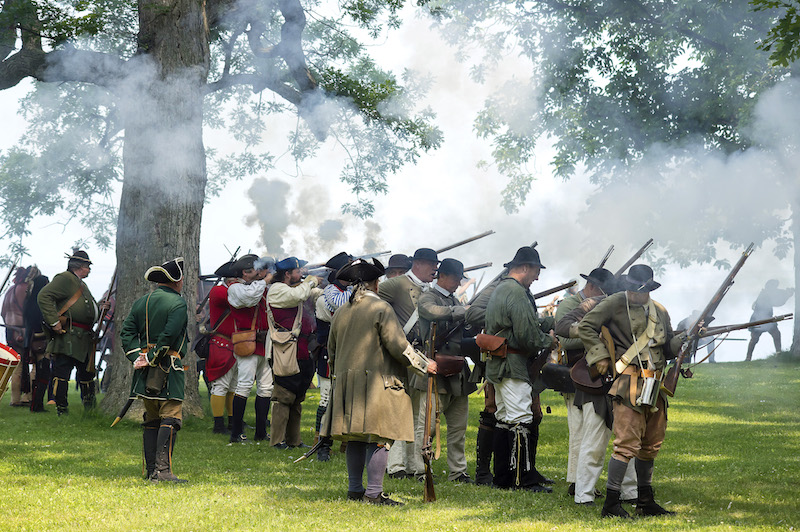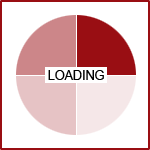Featured News - Current News - Archived News - News Categories
French and Indian War Encampment Will Fascinate and Educate Visitors for Three Days, July 2, 3 and 4
by C. Clark
(June 20,
2016) Youngstown, N.Y. - Old Fort Niagara announces its largest re-enactment of
the year, the French and Indian War Encampment, July 2, 3 and 4, 2016, when the
National Historic Landmark will portray the 1759 Siege of Fort Niagara in new
and interactive ways for the public. Hundreds of French, British and Native
re-enactors will gather at Old Fort Niagara to realistically depict the events
of July 1759, when British and provincial forces, alongside their Native allies,
laid siege to Fort Niagara for 19 days. The event also features a large camp of
18th century merchants and artisans.
New to
this annual event will be:
· Construction and exhibition of the
British sap, or trench, outside the
Visitors Center, to portray the offensive strategy used by the British to
approach and attack Fort Niagara during the 19-day siege (please refer to
photos).
· Battles, tours, programs and
activities will be different every day as re-enactors present a timeline of actual
occurrences from the conflict over the event's three days.
· New interpretive tours and vignettes
that share historical background information and explain the circumstances that
led to specific actions being portrayed.
· $30 three-day pass (available July 2
only) offers visitors a discount on multiple day admission.
"This
year's re-enactment has been designed with visitor interest and engagement in
mind," said Robert Emerson, executive director of Old Fort Niagara. "Our staff
invested time over the winter to dissect the siege and then translate it into
an interactive and engaging three-day timeline of events for the public, who
can look forward to exciting battles plus new tours and new features that will teach
them about -- and involve them in -- the circumstances that led to the British
victory and French defeat at Fort Niagara in 1759."
Special
features during the event include: engineering and exhibition of 18th
century trench defenses; French women sewing sandbags and powder bags, and treating
the wounded; kids learning manual exercises with wooden muskets and playing
period games; British artillery firing on the French and French firing on the
British; Natives and French trading furs for European goods; British and French
preparing food and feeding the troops; Natives playing lacrosse; French and
British sutlers (period merchants)
demonstrating and selling handmade products, like pottery, ironworks, clothing,
soap and food.
Summary of the French and Indian War
and Fort Niagara's Role
In the
18th century, New France's Fort Niagara occupied a strategic gateway
to the inner continent of North America via the Niagara River's connection to
the Great Lakes region and subsequent waterways. From 1754 through 1760, France
and Britain battled for control of these areas while also fighting the Seven
Years War on European soil. Following a 19-day British siege on the fort in
July 1759, France finally lost their hold on Fort Niagara and thereby lost the western
gateway to the heart of the continent.
Under
the terms of the treaty that ended the war, Britain took control of Canada and
the Great Lakes region. The war's cost led to new taxes on the King's American
subjects that spawned political unrest in the 13 colonies. Colonists like
George Washington gained their first military experience during the conflict.
This experience would serve them well during the subsequent War of American
Independence.
Re-Enactment Schedule
(Italicized activities designate battles and
public tour opportunities)
Saturday, July 2
9:00
am Doors open; $30 three-day pass
available today only
9:30 am Siege
Tour: "The French Rebuild Fort Niagara 1755-59" - This tour will explore the
physical history of the fort during the French and Indian War. The tour will
explain military engineering practices of the mid-18th century and how they
were employed to defend Fort Niagara.
10:00
am The Fur Trade: Natives and
French traders gather to barter furs for European-made goods.
10:30
am French Colors Ceremony: The
French garrison assembles in front of the French Castle to troop the colors. A
small hunting party leaves the fort.
11:00 am (Battle
Demonstration - arrive before 10:30 for shuttle to site) The British Advance:
This program explains how the British army got to Fort Niagara and who
composed the force. Soon the French hunting party appears and British forces
open fire. The French are reinforced and a battle ensues. French forces
withdraw to the fort under cover of artillery.
11:30
am The Interrogation: British
officers interrogate several French prisoners they took during the previous
skirmish.
12:30
pm Preparing the Fort
for Siege: French defenders move trade bales and barrels into the outer
works to provide cover. Artillery is also moved into the outer works and French
forces conduct a musket and artillery demonstration. This is followed by on
ongoing siege demonstration through 4:30 pm.
1:00
pm Rutherford's Embassy: British
Captain Walter Rutherford requests a parley with the French commander,
Captain Pierre Pouchot. He is escorted into the fort where he presents a
surrender demand.
1:30
pm Opening the Sap: A British
engineer explains how his forces are going to approach the fort by
digging trenches toward the post.
2:00 pm (Battle
Demonstration) French Sortie: French forces exit the fort and attack the
British trenches.
3:00 pm British Mortars: The British present a
mortar demonstration in the sap. French guns return fire.
3:15
pm Kaendae's Embassy: The Seneca
chief Kaendae stops the fighting and calls a council with the French.
4:00
pm French Bombardment: French
artillery batteries resume fire.
Sunday, July 3
9:00
am Doors open
10:00
am Kaendae's Embassy, Part Two. With
Sir William Johnson in attendance, Kaendae holds council in the British camp.
Six Nations warriors agree to withdraw from the siege and camp nearby at La
Belle Famille. Ongoing siege demonstrations through 4:30 pm.
11:00 am Siege
Tour: British and New York Provincial troops advance the sap and trade
fire with the French, who fire artillery at the approaching trench.
Noon:
Foodways: A demonstration
of camp cooking in the British Camp.
1:00 pm Siege
Tour: The British advance their artillery and open up on the fort. Artillery
and military engineering demonstrations.
2:00 pm (Battle
Demonstration) British Assault the Fort - British forces attempt to storm the fort
as French defenders stand firm.
3:00
pm Women's Program: French women
sew sandbags and gunpowder bags and treat the wounded.
4:00
pm Kids Drill: Hands-on program
for children of all ages. Join the fort's garrison and learn how to handle a
wooden musket. Children's period games.
Monday, July 4
9:00
am Doors open
10:00 am Siege
Tour: Both sides enter their lines and trade musket and cannon fire. Ongoing
siege demonstrations through 2:30 pm.
11:00 am (Battle
Demonstration) The Battle of La Belle Famille - A French relief force tries to
break through, but is defeated by British troops.
Noon Artillery Demonstration: British
guns pound the fort. French return fire.
1:00
pm Desperate Measures: British
musket fire and artillery continue to pound the fort. Many French guns are put
out of service and defenders refuse to fire over the parapet. Officers try to
motivate their men to continue the fort's defense.
2:00 pm (Battle
Demonstration) British Assault the Fort - The British successfully assault the
outer works. The French sue for terms.
2:45
pm Surrender Ceremony: British
troops enter the fort, French troops form on the parade ground. Natives help
themselves to French goods and the fort surrenders with the partial honors of
war.
Admission
Admission
to the French and Indian War Encampment is $13 per person per day, or $30 for a
three-day pass, available July 2 only.
Old Fort Niagara's upcoming events
include:
July 6-August 12 DAILY SUMMER PROGRAM Featuring
American Revolution Era at the Fort
July 9-Oct. 10
(12pm-3pm) Lighthouse Open to
the Public
Sat., July 23 PERFORMANCE Plymouth
Fife and Drum Corps
Sun., July 31 PERFORMANCE Buffalo
Philharmonic Orchestra
Sat. & Sun., Aug.
13-14 RE-ENACTMENT Soldiers of the
American Revolution
Sat. & Sun., Sep.
3-4 RE-ENACTMENT War of 1812
Encampment
Old Fort
Niagara (www.oldfortniagara.org) is
located in Fort Niagara State Park in Youngstown, N.Y., which is 14 miles north
of Niagara Falls via the Robert Moses Parkway North. The fort is open daily
from 9 a.m. to 5 p.m. through June and from 9 a.m. to 7 p.m. in July and
August. Admissions end 30 minutes before closing. Old Fort Niagara is a
Registered National Historic Landmark and New York State Historic Site operated
by the Old Fort Niagara Association (a not-for-profit organization) in
cooperation with the New York State Office of Parks, Recreation and Historic
Preservation. Follow us on Facebook, Instagram and Twitter.
(end)
Hours of Operation
January 13 through March, Open Wednesday-Sunday 10:00 a.m. to 4:00 p.m
April 1- June 30, Open Daily 10:00 a.m. to 4:00 p.m.
July and August, Open Daily 10:00 a.m. to 5:00 p.m.
September 1 - October 15, Open Daily 10:00 a.m. to 4:00 p.m.
October 16 - December 31, Open Wednesday through Sunday (Closed Mondays and Tuesdays) 10:00 a.m. to 4:00 p.m.
The fort will be open daily during Christmas week, December 26 - 31.
Closed New Year's Day, Thanksgiving Day and Christmas Day.
General Admission
|
Adults: |
$20.00 |
|
Children (6 to 12 years) |
$12.00 |
|
Children (5 and under): |
FREE |
Support the Fort
Old Fort Niagara is operated by the Old Fort Niagara Association, an independent, not-for-profit organization established in 1927. We do not rely on tax dollars. Instead, the Fort is funded through a combination of admission fees, museum shop sales, and charitable contributions.
.jpg)
Newsletter Sign-Up
Keep up to date on Old Fort Niagara events and happenings! Sign up here for our e-newsletter.


